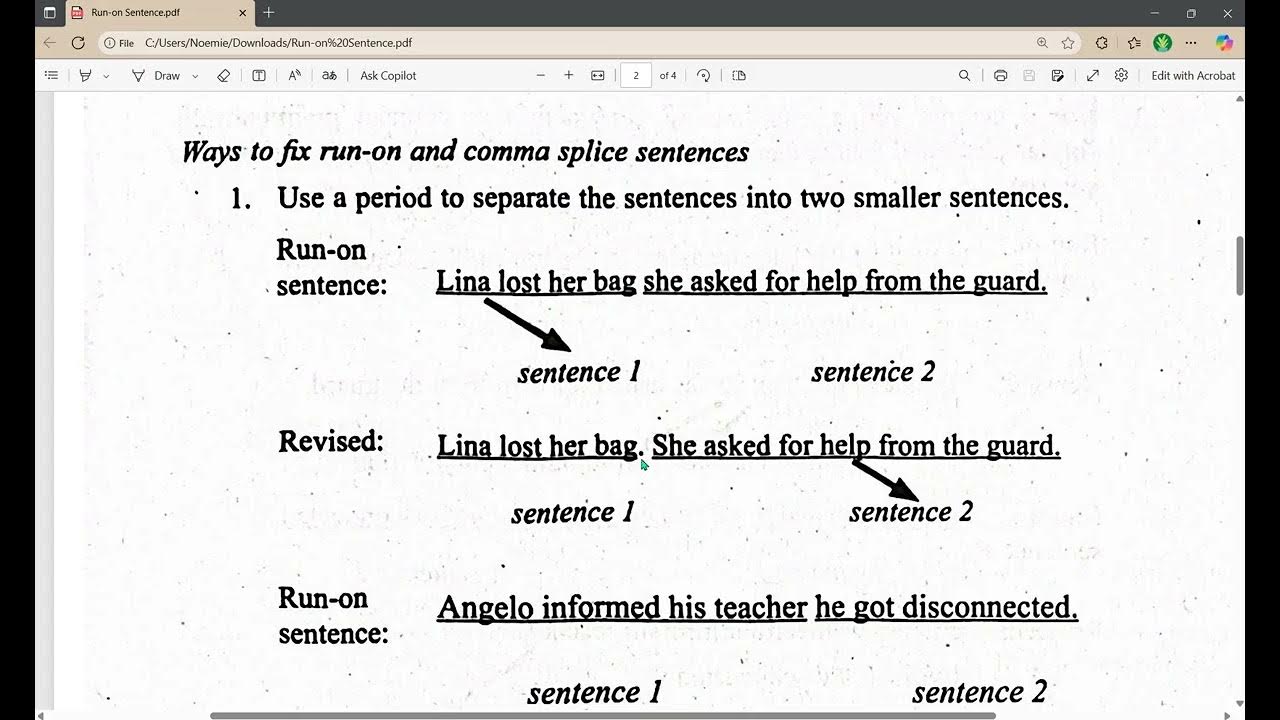Common Sentence Errors: Overview
Summary
TLDRIn this lesson, Kim introduces the five most common sentence errors in English: fragments, fused run-ons, comma splices, stringy sentences, and choppy sentences. She explains how each error occurs, provides examples, and demonstrates effective strategies to fix them, such as using punctuation, conjunctions, and varying sentence structures. With practical tips and interactive exercises, this lesson helps learners improve sentence clarity and flow by avoiding common mistakes, making their writing more engaging and grammatically correct.
Takeaways
- 😀 A sentence is a complete set of words containing both a subject and a predicate, and it connects ideas logically within a paragraph.
- 😀 A fragment is an incomplete sentence missing either a subject or a predicate, and it cannot stand alone.
- 😀 To fix a fragment, add a subject or predicate. For example, 'I am going to dinner with my friend' is a complete sentence after adding a subject.
- 😀 A fused run-on occurs when two independent sentences are joined without any conjunction or punctuation.
- 😀 A comma splice is a similar error where two complete sentences are joined incorrectly with just a comma.
- 😀 To fix a fused run-on or comma splice, you can add a period, semicolon, coordinating conjunction (e.g., FANBOYS), or a conjunctive adverb.
- 😀 Conjunctive adverbs (e.g., 'however', 'therefore') are used with a semicolon to connect related independent clauses.
- 😀 A stringy sentence contains too many conjunctions, making it long and hard to follow. It's important to break it into smaller sentences or use semicolons for better clarity.
- 😀 A choppy sentence is a series of short, simple sentences that make the writing sound elementary. It's fixed by varying sentence lengths and adding more information.
- 😀 To correct sentence errors like fragments, run-ons, and choppy sentences, focus on proper punctuation, conjunctions, and adding variety in sentence structure.
Q & A
What is the primary purpose of the first lesson in this video series?
-The primary purpose of the first lesson is to provide an overview of common sentence errors in English, including sentence fragments, fused run-ons, comma splices, stringy sentences, and choppy sentences.
What are the four types of sentences in English mentioned in the script?
-The four types of sentences in English mentioned are: interrogative, declarative, imperative, and exclamatory.
How does the script define a sentence fragment?
-A sentence fragment is defined as a group of words that looks like a sentence but is not complete. It is missing either a subject or a predicate, making it grammatically incorrect.
What are some examples of how to fix a sentence fragment?
-To fix a fragment, you can add the missing subject or predicate. For example, 'Going to dinner with my friend' becomes 'I am going to dinner with my friend.'
What is a fused run-on and how can it be corrected?
-A fused run-on is a grammatically incorrect sentence where two complete sentences are joined without a conjunction or appropriate punctuation. It can be corrected by adding a period, a semicolon, a comma with a coordinating conjunction, or a conjunctive adverb.
What is the difference between a comma splice and a fused run-on?
-A comma splice is an error where two complete sentences are incorrectly joined with just a comma, while a fused run-on has no punctuation or conjunction to connect the sentences at all.
What are FANBOYS, and how are they used in sentence correction?
-FANBOYS is an acronym for the coordinating conjunctions: For, And, Nor, But, Or, Yet, So. These conjunctions can be used to correctly join independent clauses in sentence corrections, typically after a comma.
How can stringy sentences be improved?
-Stringy sentences can be improved by breaking them into smaller sentences, using semicolons, adding commas with conjunctions, and using conjunctive adverbs to make the sentence more readable and avoid sounding too long or disjointed.
What is a choppy sentence, and why is it problematic?
-A choppy sentence is made up of short, simple sentences strung together, which can sound elementary and jerky. It can be improved by varying sentence lengths, adding more information, or using conjunctions to create smoother flow.
What strategies are suggested for fixing choppy sentences?
-To fix choppy sentences, you can add more information, switch up sentence structures, avoid starting every sentence the same way, use transition words, and incorporate semicolons or conjunctions.
Outlines

This section is available to paid users only. Please upgrade to access this part.
Upgrade NowMindmap

This section is available to paid users only. Please upgrade to access this part.
Upgrade NowKeywords

This section is available to paid users only. Please upgrade to access this part.
Upgrade NowHighlights

This section is available to paid users only. Please upgrade to access this part.
Upgrade NowTranscripts

This section is available to paid users only. Please upgrade to access this part.
Upgrade Now5.0 / 5 (0 votes)





